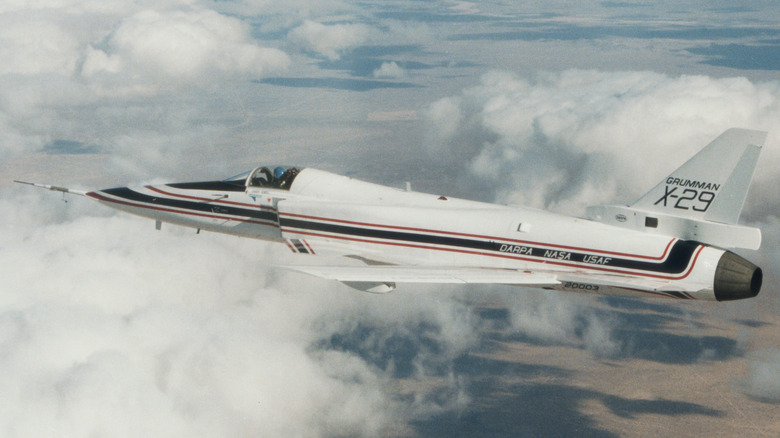Why The Grumman X-29 Is One Of The Strangest Jets Ever Designed
The aeronautical advancement that has taken place between the Wright Brothers' fateful flight and today could not have been so spectacular without the kind of experimentation that attempts to rewrite the book on what is possible in the air. The X-29 typifies such bold innovation. One look at this unique creation is all you need to realize you are looking at the very far end of aircraft design. The wings look like they were put on backwards, and there is an extra set of what look like vestigial wings right behind the pilot. These forward-swept wings and canards, as the mini-wings are called, along with the small horizontal surface behind the main wings (known as a strake) were part of a design that sought to minimize drag in the plane's flight without sacrificing stability.
Only two of the X-29 were built. The first one took its maiden flight in 1984, and both were retired to museum life by the mid-1990s. They were never in production and never used by any branch of the military outside of the testing done by the Air Force in conjunction with NASA and DARPA, which consisted of 422 research missions. This research yielded valuable innovation that greatly benefited future aircraft designs.
Unstable by design
The really striking fact about the X-29 is that its design is inherently, extremely unstable, and it wasn't just the wing design. The center of gravity of the jet was too far aft. People who worked on the project called it completely unflyable by a human pilot. Stability in flight was provided by a fly-by-wire system where a computer interpreted the pilot's intent and made micro-corrections at the rate of 40 per second, according to CNN.
The X-29 was not the first plane with forward-swept wings. One previous model, the Hansa HBF 320, is a commercial jet that first flew in 1964 and is still flying. However, its wings were only swept-forward a little. The X-29's wings go major 33 degrees, multiplying the instability. The main experimental idea the X-29 was built to prove was that the combination of the highly unusual wing design and the fly-by-wire system could deliver a low-drag, highly maneuverable fighter plane that was still stable enough to get back in one piece.
Composite innovation
There was one major problem that, before the X-29, had prevented forward-swept wings from being used on any plane that was intended to be fast and maneuverable. This problem was the tendency for forward-swept wings to twist upwards in response to the lifting force created at speed, meaning that if you went fast enough using conventional wing materials, the plane would fly apart, and quickly. New materials were needed that would stiffen the wing to resist this twisting force, without adding so much weight to the plane that performance would be adversely affected.
The problem was solved by engineers choosing a lightweight carbon-fiber material for the wings, and manipulating its properties not so much to stiffen the wing, which would have added weight even with the new materials, but to neutralize the twisting tendency. Composite materials were very new at the time of the X-29's design, and the research on this model helped develop the new technology for use in future planes, both military and commercial.
Testing
The hundreds of test flights taken by the X-29 were divided into two phases. Obviously, the Air Force wanted to test any advanced or extreme maneuvers until they had made very certain that the basic design of the jet was sound. The first X-29 built was used on missions that tested basic stability of the plane at low angles of attack, that did not challenge the new wing material too strenuously. The first phase of X-29 research showed that the twisting of the wing was controlled by the new composite materials, and that the fly-by-wire system provided enough stability (test pilots said the jet handled well), even through extreme turns. It also proved the theory that the forward-swept wings would provide improved resistance to stalling.
Phase 2 centered on high angle-of-attack maneuvers, where the bottom of the wing is exposed to the oncoming air, producing greater lift. This lift is crucial when a fighter jet needs to make tight maneuvers quickly. The second X-29 handled Phase 2, and was fitted with a parachute for spin recovery, due to the hazardous conditions being introduced. The X-29 proved that it was maneuverable and stable even at high angles of attack, despite the plane's lack of ailerons (small wings) at the end of each wing. Phase 2 also included research on releasing high-pressure gas near the nose of the plane, to interrupt and control the vortices created by the plane's nose during high-angle-of-attack flying. This was shown in a wind tunnel to help control and direct these vortices as a form of flight control.
Where are they now?
Although the X-29 helped develop emerging technologies like the fly-by-wire system, the tailoring of the composite wing materials, and the use of large canards for flight control, it did not demonstrate the marked reduction in drag that was the main impetus for its design. There was also the development of stealth technology, which quickly became a must-have feature for fighter planes. This significantly changed the priorities for new fighter models away from extreme maneuverability (to win a dogfight) to contact evasion (to make the dogfight unnecessary).
Without flying a single combat mission, the X-29 has become a part of military aviation history for its bold development of new technologies, some of which informed the design of many of the jets in use by the military today. The first X-29 built is now on display at Wright-Patterson Air Force Base as part of the Museum of the United States Air Force. The second X-29 is on display at NASA's Neil Armstrong Flight Research Center.




